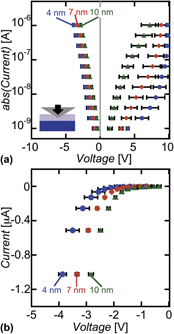Article contents
Electromechanical tuning of nanoscale MIM diodes by nanoindentation
Published online by Cambridge University Press: 27 June 2013
Abstract

Nanoscale metal–insulator–metal (MIM) diodes consisting of a nanoscale-thickness insulator layer sandwiched between two dissimilar metal layers offer the potential for very high frequency alternating current to direct current signal rectification. Active nanoscale tuning of electronic tunneling through the insulator layer to form point contact diodes has previously been limited to barriers composed of soft organic films due to the force limitations of conductive-atomic force microscopy. In this paper, MIM diodes with oxide-based insulators are formed in situ with sub-nanometer depth precision and characterized using a nanoindenter equipped with electrical testing capabilities. Simultaneous measurement of both electrical and nano-mechanical information is accomplished in an MIM stack of the form Nb/Nb2O5/boron-doped diamond nanoindenter tip. Using this technique, we show that the diode behavior can be electromechanically tuned over a range of more than 1 V at equivalent currents via small changes in indentation depth and the results can be modeled using a Fowler–Nordheim approximation.
- Type
- Articles
- Information
- Copyright
- Copyright © Materials Research Society 2013
Footnotes
This author was an editor of this journal during the review and decision stage. For the JMR policy on review and publication of manuscripts authored by editors, please refer to http://www.mrs.org/jmr-editor-manuscripts/
References
REFERENCES
- 4
- Cited by


